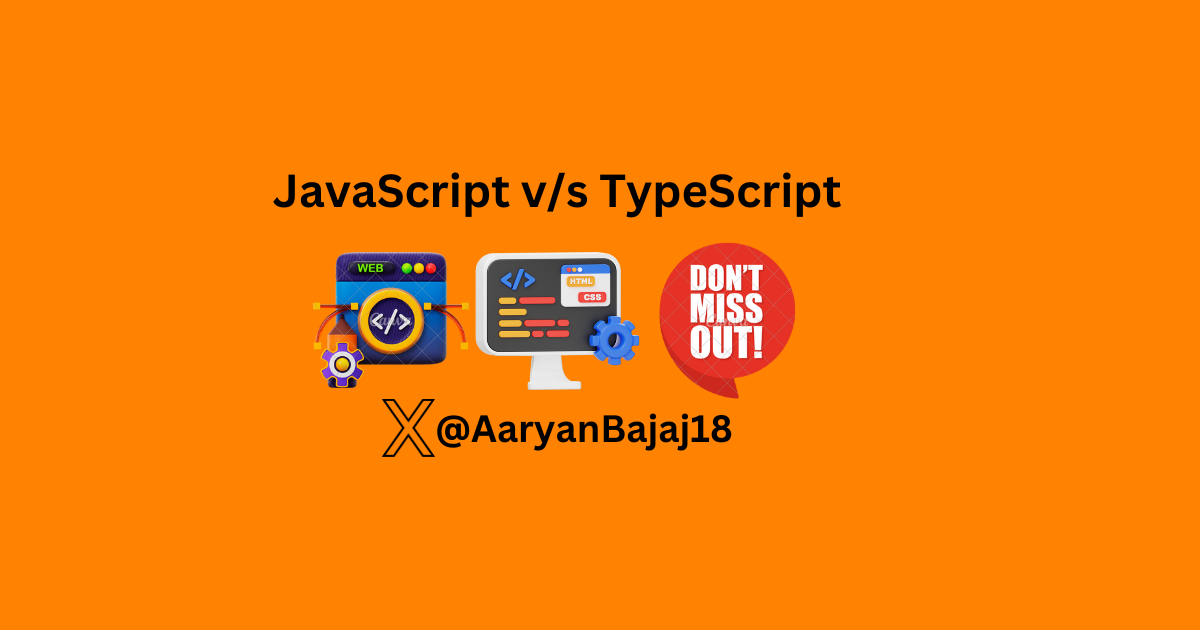JavaScript vs TypeScript: Which Should You Choose for Your Next Project?
 AARYAN BAJAJ
AARYAN BAJAJ
Introduction
In the dynamic world of web development, choosing the right programming language can make all the difference. For years, JavaScript has been the undisputed champion, powering millions of websites and applications.
However, a new contender has emerged: TypeScript. Developed by Microsoft, TypeScript promises to enhance JavaScript with additional features and improved developer experience.
But is it worth the switch? In this blog, we'll explore the differences between JavaScript and TypeScript, their use cases in production, and help you decide which one is the right fit for your next project.
Understanding JavaScript
JavaScript is a high-level, interpreted programming language that is widely used for web development. It enables developers to create interactive and dynamic websites by manipulating the Document Object Model (DOM) and handling events. Some key characteristics of JavaScript include:
Dynamic Typing: JavaScript variables can hold any type of data, and the type can change at runtime.
Prototypal Inheritance: JavaScript uses prototypes for inheritance, allowing objects to inherit properties and methods from other objects.
Event-Driven: JavaScript is well-suited for handling events such as user interactions, making it ideal for building responsive web applications.
Understanding TypeScript
TypeScript is a statically typed superset of JavaScript that compiles to plain JavaScript. It was designed to address some of the shortcomings of JavaScript by adding static types, interfaces, and other advanced features. Key characteristics of TypeScript include:
Static Typing: TypeScript variables have defined types, which are checked at compile-time, reducing runtime errors.
Type Inference: TypeScript can infer types based on the assigned values, making it easier to write and maintain code.
Advanced Features: TypeScript includes features like interfaces, enums, and decorators, which are not available in plain JavaScript.
Key Differences Between JavaScript and TypeScript
| PARAMETER | JAVASCRIPT | TYPESCRIPT |
| Type System | Dynamic typing allows flexibility but can lead to runtime errors. | Static typing catches errors at compile-time, improving code reliability and maintainability. |
| Tooling and IDE Support | Good support in most IDEs, but lacks advanced type-checking tools. | Excellent support in modern IDEs like Visual Studio Code, with powerful autocompletion, type checking, and refactoring tools. |
| Learning Curve | Easier to learn for beginners due to its simplicity and dynamic nature. | Steeper learning curve as it requires understanding of static types and additional features. |
| Community and Ecosystem | Larger community with extensive libraries and frameworks. | Growing community, with increasing adoption in major frameworks like Angular and React. |
Use Cases in Production
JavaScript Use Cases:
Small to Medium-Sized Projects: JavaScript is ideal for projects where simplicity and speed are crucial. Its dynamic nature allows for quick prototyping and development.
Legacy Codebases: Many existing projects and libraries are built with JavaScript, making it a practical choice for maintaining and extending older codebases.
Full-Stack Development: JavaScript, along with Node.js, can be used for both front-end and back-end development, streamlining the development process.
TypeScript Use Cases:
Large-Scale Applications: TypeScript's static typing and advanced features make it suitable for large codebases, where maintainability and scalability are critical.
Collaborative Projects: In team environments, TypeScript helps enforce coding standards and reduces the likelihood of bugs, improving overall code quality.
Modern Frameworks: TypeScript is increasingly adopted by major frameworks like Angular and React, providing a robust development experience with better tooling and type safety.
// Javascript code :
// example: Adding two numbers
function add(a, b) {
return a + b;
}
let result = add(5, 10);
console.log(result); // Output: 15
// example: Adding two numbers with type annotations
function add(a: number, b: number): number {
return a + b;
}
let result: number = add(5, 10);
console.log(result); // Output: 15
Conclusion
Choosing between JavaScript and TypeScript ultimately depends on your project's requirements and your team's expertise.
JavaScript remains a versatile and powerful language, ideal for quick development and smaller projects.
On the other hand, TypeScript offers enhanced features and improved reliability, making it a strong candidate for large-scale applications and collaborative environments.
Happy Coding! 🤞💻
👋 Hello, I'm Aaryan Bajaj .
🥰 If you liked this article, consider sharing it.
Subscribe to my newsletter
Read articles from AARYAN BAJAJ directly inside your inbox. Subscribe to the newsletter, and don't miss out.
Written by

AARYAN BAJAJ
AARYAN BAJAJ
Hi Everyone 👋🏻 , I'm Aaryan Bajaj , a Full Stack Web Developer from India(🇮🇳). I share my knowledge through engaging technical blogs on Hashnode, covering web development.